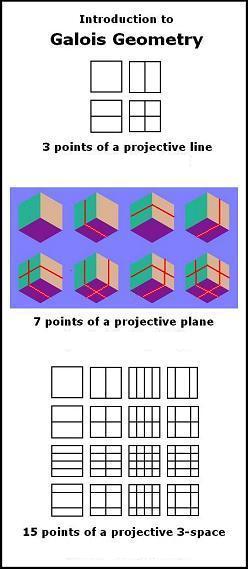 |
"Projective spaces over a finite field, otherwise
known as Galois geometries, find wide application
in coding theory, algebraic geometry, design
theory, graph theory, and group theory as well as
being beautiful objects of study in their own
right." The line diagrams at left are related to the two-color patterns at right as follows.
The three line diagrams above result from the three partitions, into pairs of 2-element sets, of the 4-element set from which the entries of the bottom colored figure are drawn. Taken as a set, these three line diagrams describe the structure of the bottom colored figure. After coordinatizing the figure in a suitable manner, we find that these three line diagrams are invariant under the group of 16 binary translations acting on the colored figure.
A more remarkable invariance -- that of symmetry
-- Steven H. Cullinane |
 |
